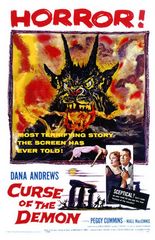Demonic Obsession?

תניא אבא בנימין אומר אלמלי נתנה רשות לעין לראות אין כל בריה יכולה לעמוד מפני המזיקין אמר אביי אינהו נפישי מינן וקיימי עלן כי כסלא לאוגיא אמר רב הונא כל חד וחד מינן אלפא משמאליה ורבבתא מימיניה
It has been taught: Abba Benjamin says, if the eye had the permission to see them, no creature could endure the demons. Abaye says: They are more numerous than we are and they surround us like the ridge round a field. R. Huna says: Every one among us has a thousand on his left hand and ten thousand on his right hand.
There is story behind my fascination with this little blurb of Talmudic fantasy. Even when learning it for the first time, I could make so sense out of it. Did the Chazal really mean actual demons? When I was about 12 years old, I was sitting around a Shabbos Tisch with some friends and some potential ba’alei teshuvah. One of these guests asked the ba’al habayis a question of Kashrus. “If one has to check and apple for worms, wouldn’t one also have to check for eggs of those worms? Assuming the eggs are also treife?”
That was a great question. I was really wondering the answer to that one myself, when the ba’al habayis came up with a terrific response. “The Torah does not require us to check our food with a microscope.” At that moment, I had a flash of what I thought to be ruach hakodesh, and instantly thought I found the secret to Abba Binyamin’s statement. It was possible that the Chazal realized there were microbes present everywhere and rightly declared that a person’s ability to see them would obscure any other sense of reality perceivable. In fact, I knew a woman at the time who believed that she could actually see germs, and would obsessively clean her home day after day. She eventually got sick and was hospitalized with severe schizophrenia, proving Abba Binyamin right!
This peshat worked well with the alternate translation of ‘mazikin’, which means demons, but literally means ‘damagers.’ Certainly, I thought, modern science has proven that so many diseases are caused by these unseen germs and viruses, so the assumed meaning of ‘demons’ as germs grew even stronger. Even the statement of Abaye seemed right on target. We know there are thousands if not millions of unseen organisms floating around us all the time, not to mention atoms and molecules, too.
It wasn’t until I bumped into Rav Huna that my little epiphany hit a glitch. How exactly did that work out that germs would know the difference between right and left? And why the preference for the right hand? One could argue that the right hand, being the dominant hand and the hand with which mitzvos are to be performed, would be the choice target of ‘demons’ wishing to hurt a Jew. But, if these demons are microbes, then how do they know the right from left? One would have to assume that these germs are programmed by HaShem to attack the right side more than the left. That’s not a stretch for the religious imagination, but it was for a kid trying to work out the problems between science and religious doctrine.
The other problems with this followed from there. Abba Binyamin did not say “no man”, but no “creature”, implying that this rule applies even to animal life. We know there are animals which have tremendously sensitive sensory apparatus and can smell and feel changes in the wind and atmosphere. Even with all the high-tech gizmos we use today, we are still finding out that animals have a greater sense of their surroundings and environments that we ever gave them credit for. The recent Tsunami is evidence enough of that. So why would someone as intuitive enough to work out the microbe problem, not be intuitive enough to know that animals have heightened and powerful senses?
Next came the problem of microbes in general. How could they have imagined microbes as ‘mazikin’ on the outside and all around, yet not have known that there were also benevolent and life sustaining microbes living on the inside of our bodies? It’s a pretty simple question. I do not have the answer.
The conclusion from all this is that Abba Binyamin, Abaye, and Rav Huna must have believed in the literal existence of invisible demonic forces that plagued the right hand, made the Beis Medrash feel crowded, wore holes in our clothing, and could be detected through weird voodoo rituals. There is no other way to explain their statements.


12 Comments:
Shlomo, please please tell me this entire post was written tongue in cheek.
Shira,
Read the rest of the sugya and then you tell me if I am serious or not.
Gemara Brochos 6a...They are learning it right now for the Daf Yomi. How do you think I decided on this topic?
Kol Tuv
And Nostradamus really meant that the planes would crash into the towers. What else would he have meant by eagles???
There's no reason whatsoever to credit them with knowledge of microbial life. You're backfitting your knowledge onto them; it's you that's making it fit the words, not them.
Misnagid,
Right. But remember this attempt at retrofitting and reassessment occured when I was 12, not 42. The Daf Yomi reminded me of the whole episode.
Ultimately, and I'm sure you read to the end, my plan to somehow explain away that notion was contradicted by the notion itself. As usual.
Shlomo, what if Abba Binyamin, Abaye and R Huna are speaking metaphorically, rather than about unseen literal demons, microorganisms or copepods? "There's a lot of bad stuff out in the world and if we didn't have the ability to tune it out, we'd be paralyzed into inaction." Regarding the thousand in the left hand and ten thousand in the right, it's a reference to Tehillim/Psalms 91:7 (Yoshev beseter elyon...) "A thousand shall fall by your side and a myriad to your right, it shall not reach you." (Yipol mitzidha elef urevavah miyeminecha, elecha lo yigash.) Jives with R. Nachman's comment about a narrow bridge.
Ben (who's trying to tune out a lot of demons right now.)
Ben,
That's a possibility. I know that RamBam for example believes that many or most of such statements MUST be metaphoric.
BUT, if they were, then why all the voodoo? Why all the burning of cat entrails and sprinkling around the bed? And what about the story of the guy who tried it and succeeded in seeing these 'demons'and became sick from it? Reading just 3 lines beyond Rav Huna gives one the impression that somebody of great stature took this very seriously.
Good luck with the demons.
Kol Tuv
Perhaps those are metaphors, too. Perhaps they're having a "tall tales" competition (milata debedichuta.) Perhaps the're pulling each other's legs. Or perhaps it's like that piece in the Passover Haggadah, where three rabbis use textual clues to expand the 10 plagues into 50, then 200 then 250. In my family, we make "inhale and pass the joint" gestures when we recite this section.
This sugya brings to mind the Yehudit Ravitz lullaby "Nothing can touch you/Bach Lo Nogeah" http://www.bu.edu/hillel/kol_echad/music/translation/bach.shtml
There are big bears in the forest
and its scary
There are owls and snakes dancing in front of a fire
There is a monster in the river hungry and empty
But the room is warm and nice and you are sleeping
The breath of your mouth is simple, quiet and calm
Nothing will scare you
Nothing can touch you
There is a war in the Europe
The days are dark
People flee without homes
Because of the bad people
You can't even distinguish the
Crazy people that you might meet
But the room is warm and nice and you are sleeping
The breath of your mouth is simple, quiet and calm
Nothing will scare you
Nothing can touch you
Thanks for the wishes,
Ben, (who might benefit from inhaling a real joint)
LOL
Maybe, but then you have to wonder what else they were 'joking' about that Klal Yisroel has been taking seriously all these years.
Re; The Hagadah
There is actually a rationale behind that. If you look at any natural disaster, let's say the recent Tsunami, the tsunami is a very bad things, but there are perhaps dozens of inevitable and unintended tragic consequences that arise from it.
So each makah was an event, and the rest might be considered as sub-makahs.
No?
Wow, so true, and sad.
Ben (now feeling guilty for attributing rabbinic wisdom to chemical substances...)
Wow, Shlomo, the rationale you came up with for the haggada is good, really good.
And Ben, I like your style. Keep those parentheses going.
I know it isn't Pesach yet, but when you think about what the Mitzriyim endured, they must have been very a tough and determined people, perhaps too much so for their own good.
If you look at any nation during a time when their way of life is threatened, such resistance is usually held to be honorable. The Mitzriyim always had my respect for holding out in spite of their sufferings.
This comment has been removed by a blog administrator.
Post a Comment
Subscribe to Post Comments [Atom]
<< Home